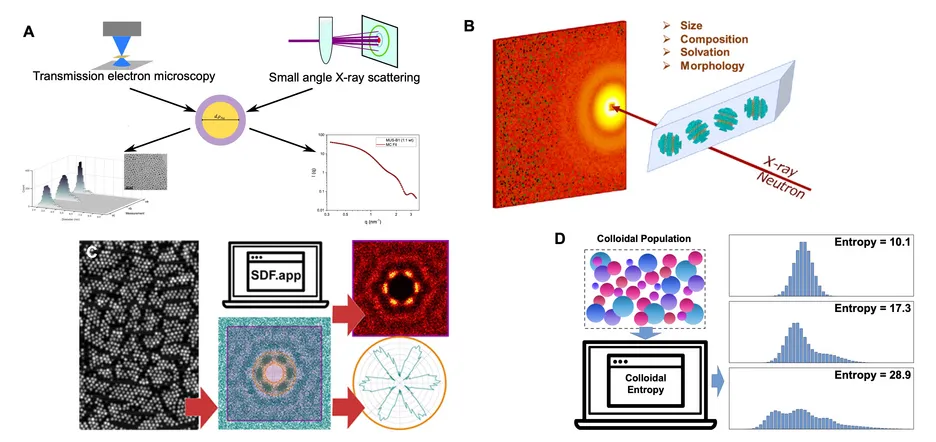Advanced Characterization and Analytical Tools

The properties of any colloidal material are intimately linked to its structure at multiple scales – from the size and shape of individual building blocks to the spatial arrangement of their assembly. Therefore, advanced characterization is central to our research. We combine scattering techniques and microscopy to capture a comprehensive picture of colloidal systems. For example, we employ Small-Angle X-ray Scattering (SAXS) alongside Transmission Electron Microscopy (TEM) for comparative analysis of polydisperse colloidal populations. Scattering methods probe ensemble statistics that complement real-space imaging: SAXS and its variants (including Mid-Angle X-ray Scattering, MAXS) reveal average size, shape, and interparticle spacing in colloidal dispersions, while electron microscopy provides direct visualization of individual particles. We also utilize Small-Angle Neutron Scattering (SANS) to gain contrast in systems where X-rays may be less informative, leveraging differences in neutron scattering length to highlight specific components. These tools allow us to investigate colloidal properties such as size distributions, aggregation state, and interactions under various conditions.
In addition to conventional techniques, our group develops innovative analytical methods to extract more information from characterization data. One such advancement is the use of the Spatial Distribution Function (SDF) to quantify 2D structural organization in self-assembled materials. By analyzing microscopy images in terms of spatial correlations (in Cartesian or polar coordinates), we can rigorously describe ordering and symmetry in 2D arrays of pores or particles. Another tool we pioneered is an information entropy-based metric for colloidal dispersity. Traditional measures of particle size distribution (e.g. mean and standard deviation) assume a normal distribution and often fail for mixtures of different sizes or shapes. We developed an assumption-free entropy metric that objectively captures the polydispersity of a sample. Because it is a highly general descriptor, this metric is also well-suited for machine learning and other advanced statistical analyses of colloidal data.
To support the community and ensure reproducibility, we openly share many of our analysis tools. For example, our group has released open-source software (such as the CORDERLY toolkit for colloidal ordering analysis) and publishes detailed tutorials of these methods. By integrating cutting-edge experimental characterization with robust data analysis, we aim to build a deeper, quantitative understanding of colloidal systems.